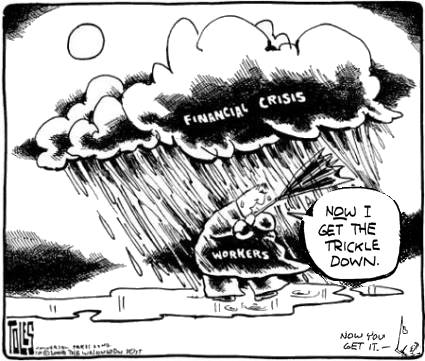
Thursday, October 16, 2008
Spend Valentine’s Day With John Ashcroft!
Nothing says "I love you" like a romantic cruise with John Ashcroft and Tom Tancredo. The Young America's Foundation cordially invites you to "surprise your sweetheart" with tickets to a ten-night adventure on the high seas with a bunch of über-conservative old white dudes. Because trust me–no girl can say no to spending Valentine's Day sharing "pressing thoughts with individuals who have done so much to advance the Conservative Movement."
Here's the saccharine, weirdly timed invitation (click to enlarge):
Prices start as low as $4,281 per person, so you better reserve your spot while it's still available.
http://www.pushback.org/2008/10/15/spend-valentines-day-with-john-ashcroft/
The Congressman Most Likely to Accept Your Friend Request
Rep. Jose Serrano (D-N.Y.) is really into Facebook. We're talking about a guy who turns 65 later this month, and he doesn't even call it "the" Facebook, the way a certain other person, in the very highest echelons of government, once famously referred to "the" Google.
"I just passed 1,200 friends!" Serrano excitedly told On the Hill yesterday.
Most every member of Congress has an official Facebook fan page, marked by the same official photo of a waving American flag. But Serrano actually has his own personal Facebook page, which he operates without the help of staff. He constantly updates it, adds new photos he takes himself, and shares his thoughts on everything from the delicious avocado he ate the other day to his beloved, beleaguered Yankees to his hope that Barack Obama is elected president.
McCain's brother blasts campaign strategy
In e-mail statement, he calls on top aides to "Let John McCain be John McCain"
- By Paul West
 WASHINGTON - Frustrations inside John McCain's camp boiled over on the eve of Wednesday night's presidential debate as the candidate's brother unleashed an e-mail blasting the campaign's "counter-productive" strategy.
WASHINGTON - Frustrations inside John McCain's camp boiled over on the eve of Wednesday night's presidential debate as the candidate's brother unleashed an e-mail blasting the campaign's "counter-productive" strategy."Let John McCain be John McCain," wrote Joe McCain in a missive sent out shortly before midnight Monday. "Make ads that show John not as crank and curmudgeon but as a great leader for his time."
McCain's younger brother was sharply critical of unnamed top campaign officials who "so tightly 'control the message'" that they are preventing reporters from speaking with those, like himself, who know the candidate best. His complaint echoed those of other McCain intimates who have chafed for months at orders not to speak with the news media without advance permission from the campaign.
The younger McCain called this news management strategy "counter-intuitive, counter-experiential, and counter-productive" because it conflicts with his brother's reputation for openness. The clampdown "has gradually bled away all the good will that this great man had from the press," he wrote.
Top Tampa GOP Figure Circulates Joke About Killing Obama
When asked about the e-mail, Austin said it was a mistake and apologized and that he wouldn't knowingly have circulated it. He said he planned to send an apology and retraction to the same e-mail list.

Al Austin/ Tribune file photo
The joke concerns a group of schoolchildren discussing the definition of "tragedy" as opposed to "great loss" or "accident." The punch line comes when one child says that if an airplane carrying Obama and his wife, Michelle, "was struck by a 'friendly fire' missile and blown to smithereens," the event might be a tragedy "because it certainly wouldn't be a great loss, and it probably wouldn't be an accident either."
Austin acknowledged sending the e-mail to his list of political contacts but said he forwarded it without fully reading it and didn't know what it said. That list included at least two reporters.
Banjo brain surgery
 by Vaughan
by Vaughan
 Surely this must be the greatest headline for a BBC News story ever: Banjo Used in Brain Surgery.
Surely this must be the greatest headline for a BBC News story ever: Banjo Used in Brain Surgery.
Although the banjo wasn't in the hands of the surgeons it was still an essential part of the operation. It was played by legendary Blue Grass musician Eddie Adcock who was having surgery install a deep brain stimulation device to treat an essential tremor that had been affecting his playing.
The BBC News story has a video of the neurosurgery and the banjo playing, and it is pure genius. Probably the best thing you'll see all year.
Essential tremor is a condition where there is a continuing deterioration in areas of the brain that control movement. This causes a tremor that usually appears when the person tries to act or move, although can lead to a 'resting tremor' that's also present at other times.
Essential tremor is not Parkinson's disease, which, while also associated with tremor, is a much more serious and disabling condition in many ways. There does seem to be a link though, as people with essential tremor are more likely to develop Parkinson's, although this still only happens in the minority of cases.
However, deep brain stimulation can be used to treat the movement difficulties of both Parkinson's and essential tremor. It involves sinking an electrode into the thalamus, a deep brain area that is part of the motor loop - a circuit that helps co-ordinate movement.
In fact, there are two parts to the motor loop - the direct and indirect pathway - an each play a complementary part in directing movement, and each of which needs to be balanced with itself and with each other. When damage to these circuits affects this balance, the result is that it causes too much activity one way, which causes a compensatory response the other, and so on.
Imagine two people, completely unaware of each other, trying to balance an uneven seesaw. The oscillations in the control system cause oscillations in movement, and this is what you can see in tremor.
DBS works by sending electrical impulses at a certain frequency into the thalamus to dampen down the oscillations. However, the oscillatory push-push cycle is not the same for everyone, and the best spot in the motor loop itself will also differ.
To get the best result the surgeons tweak the electrical pulse settings and try different areas.
To make sure it's having the desired effect, the patient is awake and they ask them to move. When they see that they've hit the sweet spot and the pulses are in time, they know their job is done.
http://www.mindhacks.com/blog/2008/10/banjo_brain_surgery.html
Joe the Plumber
McCain Hearts ACORN! Was Keynote Speaker at Group's 2006 Rally!
 Blogged by Brad Friedman
Blogged by Brad Friedman Golly, for a group that's committed so much "voter fraud" for so long (if you're gullible enough to believe the lies that RNC/FNC has been telling you) it's mighty strange that, as News One notes, "McCain attended an ACORN convention just two years ago."
Golly, for a group that's committed so much "voter fraud" for so long (if you're gullible enough to believe the lies that RNC/FNC has been telling you) it's mighty strange that, as News One notes, "McCain attended an ACORN convention just two years ago."
The once-honorable Republican's campaign has even seen fit to produce a video smear ad, attempting to tar Obama with "associations" with ACORN, and alleging the group has committed "massive voter fraud" to boot! (They've yet to produce any actual evidence for that, unfortunately.)
But more than just attending the ACORN-sponsored February 2006 rally, ACORN confirms in a statement today that McCain was actually the keynote speaker!
So now, they wonder, why it is that McCain seems to have "lost that loving feeling"?
Palin as President
Run your mouse over all the objects in the room and on the windows and doors. When the cursor changes to the 'hand', click!
Palin As President
I.O.U.S.A.
Robert Bixby, head of the nonpartisan Concord Coalition, testifies before Congress.
 A letter to our grandchildren, Raven, Emil and Taylor: I see you growing up into such beautiful people, and I wish all good things to you as you make the leap into adulthood. But I have just seen a documentary titled "I.O.U.S.A." that snapped into sharp focus why your lives may not be as pleasant as ours have been. Chaz and I had the blessing of growing up in an optimistic, bountiful America. We never fully realized that we were paying for many of our comforts with your money.
A letter to our grandchildren, Raven, Emil and Taylor: I see you growing up into such beautiful people, and I wish all good things to you as you make the leap into adulthood. But I have just seen a documentary titled "I.O.U.S.A." that snapped into sharp focus why your lives may not be as pleasant as ours have been. Chaz and I had the blessing of growing up in an optimistic, bountiful America. We never fully realized that we were paying for many of our comforts with your money.Let me explain. There is something called the "national debt." In the movie's interviews with ordinary people, it has a hard time finding anyone who knows exactly what that is. Well, I've never exactly known, either. I thought I knew, but it never came up in conversation, and it became a meaningless abstraction, even though in 2009, the debt will pass $9 trillion. You might think of those as dollars our nation has spent without having them.
What will this mean to you? It will mean you will live in a country no longer able to pay for many of the services and guarantees we take for granted. In 40 years, when you are still less than my age, it looks like the government will only be able to pay for three things: Interest on the national debt, "some" Social Security and "some" Medicare. It will not be able to afford any of the other functions it now performs.
How did we get into this situation? With a federal government that has been throwing bad money after good. Of all the presidents in the last century, the only one who was able to achieve a balanced budget and produce a surplus was Bill Clinton. He did that by bravely raising taxes and cutting spending. Our current president, George W. Bush, is now finishing up eight years of throwing around money like a drunken sailor. His fellow conservatives, like Rush Limbaugh, like to talk about "tax and spend Democrats." But they seem to be "don't tax and spend even more Republicans."
Not that this film takes sides. It is non-partisan and includes many Republicans who agree with its argument that the country is headed for disaster within the lifetimes of many now living.
42 WRITERS FOR LIBERTY
![]()
Welcome to the 42 Writers for Liberty website, part of Liberty's urgent campaign, Charge or Release. The campaign opposes the Government's current proposals to extend pre-charge detention in terrorism cases from 28 to 42 days.
The site is constructed as a calendar to illustrate graphically the sheer length of time it is proposed that a person be held without being charged with any offence. Simply click on a day to open up a text from one of the 42 writers who have contributed to the project. You may find a story, an essay, a poem, a statement or even an interview – all a response to the simple question 'What do you think of the proposed extension to 42 Days?'
It is a measure of the unpopularity of the proposed legislation that not a single writer declined to contribute on the grounds that they in fact supported it. Whereas 42 of the best novelists, essayists, memoirists, poets and journalists around sent us the uniquely powerful contributions you will read on this site.
We would like to thank all of the writers involved, as well as the site designer Richard McCoy and the staff of Liberty.
With your help, we can stop this now – please do circulate the site URL as widely as you can and visit www.chargeorrelease.com for more information about the campaign. The more pressure on the Government now, the less likely this unjust proposal is to become law.
Hari Kunzru
Simon Prosser
Anya Serota
Rush Limbaugh Says Angry Blacks Are In 30 Year Plot To Train Black Children as Militants
By John Amato
As we are witnessing, the conservative movement is in shambles now and the only thing they can do is spew racist hatred out into the world and hope it sticks to their audience in droves. And how is the conservative right going to make sure race is all you can think of when you think of the name Obama?
How about by making the case that blacks in general are lazy, angry, and engaged in a 3 decades old plot to train black children as militants against the US? It's those scary black terrorists again. Don't think anyone would actually SAY that? Think again. Listen to it in Rush Limbaugh's own words.
http://crooksandliars.com/john-amato/rush-limbaugh-says-blacks-are-angry-and
Cancer of the Devil
by Olivia Judson
Last week, the International Union for Conservation of Nature (IUCN) released its latest report on the state of the world's species. It makes for gloomy reading. Although there have been a few triumphs — species increasing their numbers thanks to conservation efforts — the general picture is one of decline. A quarter of all mammal species are now endangered, mostly because their habitat is disappearing. But of all the mammals now on the endangered list, from the fishing cat to the Caspian seal, the most startling is the Tasmanian devil.

Tasmanian devils live on the island of (surprise!) Tasmania, off the south coast of Australia. They are marsupials: their young are born tiny (about a third of a gram — that's a hundredth of an ounce), then fed on milk and carried in a pouch. As adults, devils are thick-set, thuggish-looking animals, with massive teeth that they use to chomp up carcasses, bones and all. Although they are far from enormous — the biggest males weigh in at around 14 kilograms (30 pounds), about the size of a French bulldog — Tasmanian devils are the largest carnivorous marsupials to have, so far, escaped extinction.
But over the last 12 years, the population has crashed — in some areas, population numbers have fallen by 90 percent. The dramatic decline has led the IUCN to move the species from "least concern" a decade ago to "endangered" now. Some think it could be extinct within 25 years. The reason? An infectious cancer.
Some human cancers are infectious in the sense that they are caused by infectious viruses. Cervical cancer, for instance, is caused by human papilloma virus, which spreads from one person to another during sex.
But the cancer that's killing the Tasmanian devils is different. The cancer cells themselves are infectious.
http://judson.blogs.nytimes.com/2008/10/14/cancer-of-the-devil/index.html




















